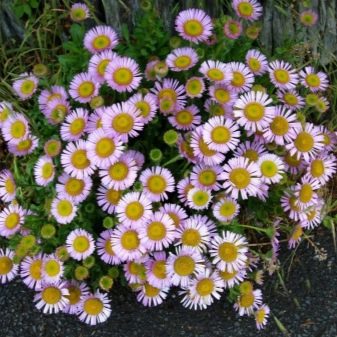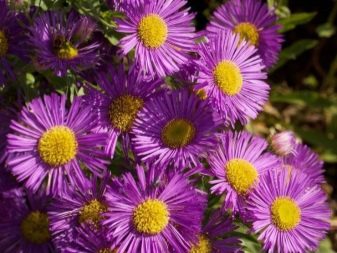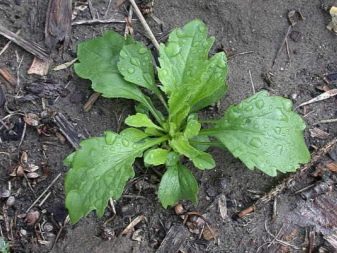What does erigeron look like and how to grow a flower?

Perennial erigeron blooms throughout the summer, which attracts many gardeners. The advantages of this culture include its perfect unpretentiousness.
general description
The second name of the flower, erigeron, sounds like "small petals" due to the abundance of long needle-like petals. The translation from the Greek main name is also interesting: "erigeron" means "early elder", which is due to the early ripening of seeds. Culture is a representative of the Astrov family. The perennial plant forms loose spherical bushes with a width equal to 40-60 centimeters and a height ranging from 15 to 70 centimeters. On soft, actively branching shoots, there are dark green leaf blades of an oblong shape. The flowers grow separately, mainly at the tops of the stems, or they are combined into paniculate inflorescences.
Opened buds can be pink, white, yellow, blue or otherwise. The lush center is painted in a bright yellow shade. Simple petals go in one row, and double petals form several. The diameter of the basket is 2 to 4 centimeters. The flowering period of erigeron lasts from early summer to October, although some hybrids only bloom in early and late summer. Small grains covered with fluff ripen very quickly.


Popular species and varieties
One of the most popular types of flowers is the small-petal dove, also known as the coastal aster. In height, the herbaceous perennial does not exceed 20-40 centimeters. Powerful branching shoots grow both spreading and erect. Both the stems and the leaf blades have a bluish-green color, as well as sufficient fleshiness. The shade of the opening buds ranges from rich purple to delicate lilac. The bloom of the variety lasts from mid-July to September. Frost-resistant erigeron is able to withstand cold snaps down to -40 degrees.

The small petal blooms beautifully in July or August throughout the month. During this period, the bush is covered with large inflorescences collected from baskets with a yellow center and purple petals. Herbaceous perennial has a shortened, horizontally developing rhizome. The height of the shoots reaches 70 centimeters. The most popular are the following varieties of beautiful small petals:
- "Violetta", the marginal flowers of the inflorescences of which have an ink shade;
- lilac "Wuppertal";
- "Dunkel's Eagle" with ultramarine marginal buds;
- “Summer”, some of the flowers of which change color from white to pink.


A variety called hybrid small petal combines varieties obtained on the basis of beautiful erigeron. The stems are about 50 centimeters high. The flowers are usually pink, lilac or purple. The most popular varieties of this type are:
- "Darkest" with straight thin petals;
- "Summer new snow" with brown shoots and white-pink petals;
- "Azure beauty" of lavender shade.


In horticulture, small petals such as Karvinsky's erigeron are also involved. A small bush, the height of which hardly exceeds 15 centimeters, and the width is 60 centimeters, is used for ampel cultivation.Creeping shoots are abundantly covered with foliage. During flowering, the shade of the petals changes from pale pink to practical white, and then to hot pink and crimson. This variety includes varieties:
- "Pink diamond" with double pink-violet flowers;
- miniature multi-colored "Treasures of Agra";
- "Pink treasure", outwardly very reminiscent of an aster.
Erigeron orange is characterized by the presence of lush orange inflorescences, sitting on medium-sized bushes with a height of 40 to 50 centimeters. Among gardeners, its hybrids are especially appreciated:
- "Rose Triumph" with dark pink double flowers;
- Prosperity covered with blue baskets.


Erigeron glaucus has graceful pink buds with yellow-orange centers. Usually the height of this perennial does not exceed 20 centimeters. Erigeron triphidus, which is remembered for its large flowers on tall bare stems, Erigeron yellow and Erigeron flatta are also small.
Mention should also be made of such types of small petals as:
- daisy-leaved, changing color from pale pink to white and raspberry;
- alpine, forming an almost spherical bush with pink or lilac flowers;
- Philadelphia with purple and white buds reaching 3 centimeters in diameter.
Hybrid varieties are quite popular, such as:
- "Rose of July" with large single baskets of pink-lilac color;
- "Pink lotus" with large inflorescences;
- "Colored carpet";
- "Blue carbuncle".


Growing seedlings
It is customary to pre-grow seedlings from seeds in northern regions with long cold winters. The procedure is usually carried out from the beginning of March to the beginning of April, as the small petals develop very slowly. The pots or boxes are filled with nutritious, spray-moistened soil. The grains are distributed evenly over the surface with slight indentation. You do not need to sprinkle them with earth.
In a common container between individual seedlings should be kept from 2 to 3 centimeters. If erigeron is planted in individual containers, then each should contain 2-3 seeds - in the future, only the strongest sprout is left of them, and the weak will need to be cut off.
The containers must be covered with cling film or covered with glass. For successful germination of the culture, it is necessary to maintain a humid environment and a temperature from +10 to +15 degrees. If possible, the pots are taken out on a closed balcony or left on the windowsill. Watering the developing seedlings should be done with a little warm water.
If the plants become cramped in the common container, then they will have to dive into separate cups a month after sowing.


Landing in open ground
Planting seeds in open ground is carried out both in spring and autumn. At the beginning of the season, the procedure is carried out as early as possible, and in the fall it is better to wait until the end of Indian summer and the establishment of cool but dry weather. To plant the grains in the soil, you first need to dig up the entire bed, and after the earth subsides, level the surface. Since the grains are small, it is recommended to close them up by no more than 1-2 centimeters. A gap of 25-30 centimeters is maintained between the rows. The grooves are covered with peat or humus, after which they are moderately irrigated.
After the emergence of seedlings, they will need to be thinned so that at least 10 centimeters of free space remains between the seedlings. If the spring is rainy, then watering the beds is not required at all. In dry and warm weather, Erigeron will have to be moistened periodically. The grown plants will have to be planted at a distance of 30-40 centimeters.
Seedlings on open ground are carried out in spring after the end of winter frosts, when the temperature becomes stable warm. In principle, in some regions this can be done at the end of March.
You have to act carefully, ideally by transshipment. The bushes are planted at a distance of about 25 centimeters from each other.


The nuances of care
Small petals do best in well-lit areas, without stagnation of moisture in the ground. It is optimal if it is loam or neutral soils with good drainage. The plant needs moisture only during dry periods. Tall bushes must be tied up or fixed on supports. Dried buds are pruned in time to prolong flowering.
Adult specimens hibernate without additional shelter, while young specimens require autumn pruning and mulching with dry sawdust and foliage. If Erigeron falls ill with fungal diseases, then the soil near it will need to be sprinkled with ash, and the bush itself should be sprayed with a 1% solution of Bordeaux liquid.

Reproduction
Small petals can be propagated in several ways.
Cuttings
For grafting, it is necessary to prepare the stem with part of the rhizome. The workpiece is kept in a stimulating solution for 1.5-2 hours, after which it is rooted in water, wet peat, humus or sphagnum.
For a plant to have roots, it needs to be in a warm and well-lit place. This usually happens after 3-4 weeks. A month later, Erigeron is sent to his permanent habitat.

Seeds
The seed propagation method was mentioned above, but it should be added that small grains on open ground should be sown very densely. This is explained not only by their miniature size, but also by non-friendly germination.
It is possible to collect seed from your own plants. To do this, several inflorescences are left on the bush after the first wave of flowering. At the beginning of autumn, having time before the arrival of the rains, the dried boxes have to be collected and stored. It should also be mentioned that it is recommended to soak the seeds in a biostimulating solution for 15-20 minutes before planting.


By dividing the bush
It is customary to combine the division of the small-petaled bush with a transplant. This procedure is carried out both before the beginning and at the end of the period of intensive growth. Only a healthy and adult bush 2-3 years old is to be used. The plant is carefully removed from the soil, after which the earth is shaken off from the roots. The bush is divided into 2-3 parts, and, where possible, the roots are unwound.
All actions are carried out using disinfected tools: shovel, knife, scissors or secateurs. The opened wounds are sprinkled with crushed chalk, cinnamon or activated carbon. The resulting cuttings are immediately transferred to new habitats.


Application in landscape design
Erigeron is actively used in landscape design. Low-growing varieties are used as hanging plants, and are also located in flowerpots near porches or arbors. Tall bushes are ideal for lining paths and decorating lawns. Dwarf small petals form a neat and beautiful border. The flower can also become part of an alpine slide or rabatka.









































































































The comment was sent successfully.